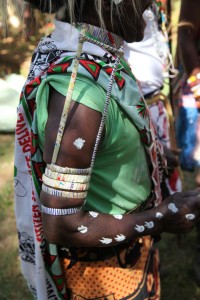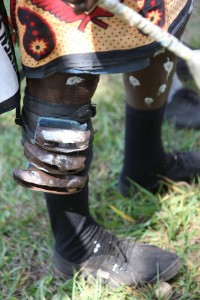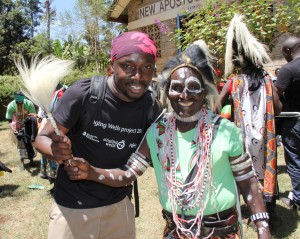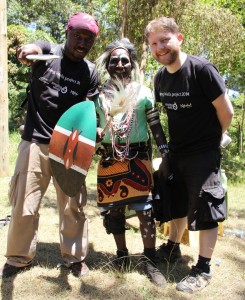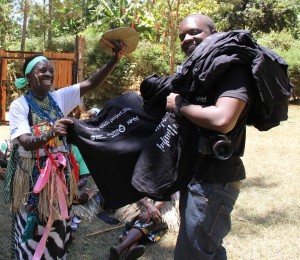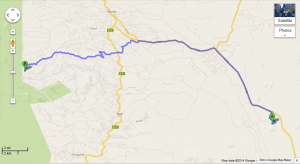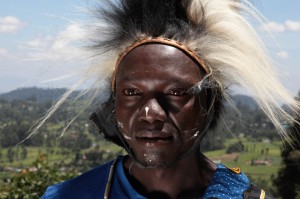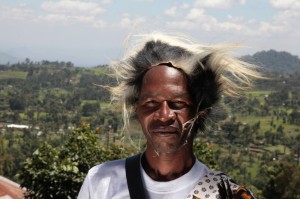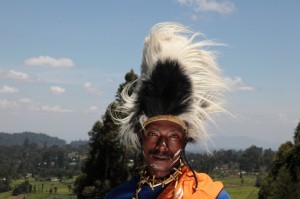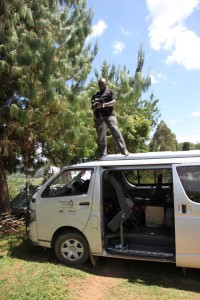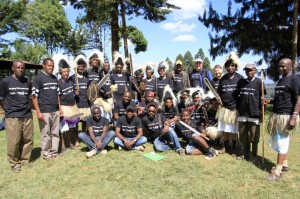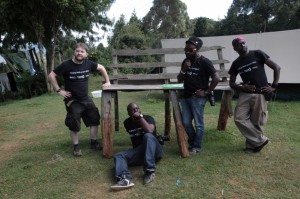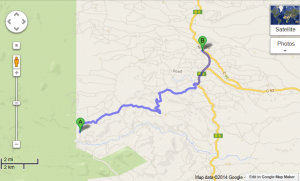This day is mostly about the Ameru, or Meru, and their dance troupes. We recorded 32 separate songs across 5 performers in four separate locations. On the way, we learned a lot of detail of the boys’ rite of passage through circumcision.
After breakfast (each of us coming at separate times), we travelled an hour to Mariene, to record our first group on the grounds of the New Apostolic Church. This was our route:
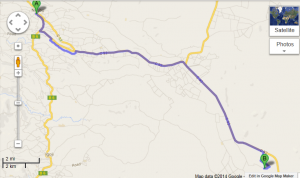
It was a lovely location, deep in the trees, with the performance area nestled between the church and a small stream.
The Music Groups
Mariene Traditional Dancers
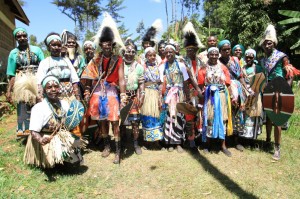
This group formed in 2003 and is led by Simon Munuki. They are from the Ameru Ethnic Community. Their musical style is Kirarire and Authi.
The lead singer wears Murungi, an ornament on both sides of the arms which is worn by the initiator/circumciser; it signifies a man of respect and authority.
Their costumes include Lesos, necklaces, face painting, spears, fly whisks, gourds, and head gear, called Nkoroi made out of cow skin, with Monkey hide. The women cover themselves with green head scarves. The group uses the Kibere (shaker), performed by Jeremiah M’Mbiwiriaft, and the Coro (the flute), played by Simon Muriuki.
The group played five songs, plus performed three magic moments:
- Arabamba Mwarone
- Mpandi mautini
- Kirarire: Song about pre-cirumcision; they are calling out to all that can hear that they boys are ready.
- Wikiri
- Mariri: Song is about herding… He asks a woman for thin porridge which is kept in the gourd during long trips away. He meets someone else that wants the gourd and dies with it. In the song he calls for those who will really listen to what he has to say (this is the wonderful refrain at outset)
- Magic Moment: Simon doing gospel interpretation of Mariri.
- Magic moment: Arabamba mwarone as vocal solo with lead vocalist
Their costumes were wonderful:
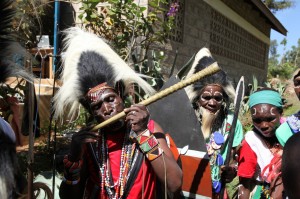
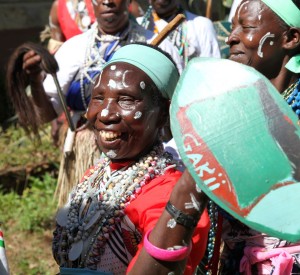
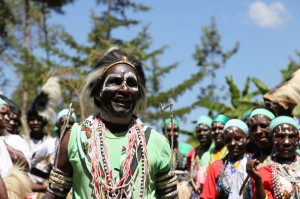
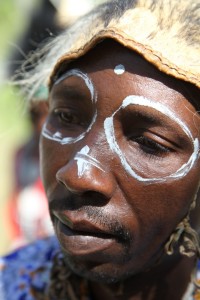
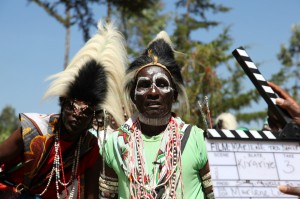
Before we left we gave everyone Singing Wells t-shirts:
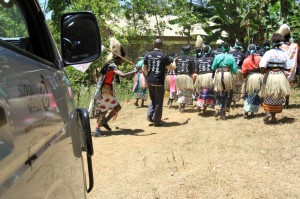
We then broke down the set and as we were departing the group led the van off the site and wished us good travels. We drove to Murungurune, where we met our local contact, Chief Kimathi, and then had a hard 3-4 kilometers ride up a very rough dirt road through the Ruthumbi forest to a high hill that overlooked the beautiful green valley below. Here’s our route:
Irimbene Cultural Dancers and Self Help Group
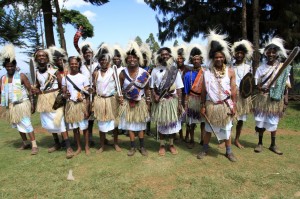
This group formed in 2000 with 21 young men. They are led by Edward Kiogura. This is Authi style, they are Ameru from the Irimbene Village, upper Kiungone Sublocation, Abogeta West Division.
The group uses Mbere (shakers) worn by Bernard Nkonge, Ginfold Mbae, Amos Munthi and Fraras Ikunda. They also use a flute, Coro, is performed by John Mwiti. The group was in beautiful costume and so energetic – to be frank, and in contrast to Uganda, we don’t get a lot of young people in the groups in Kenya, and it is rarer still to have young men. It was a great pleasure to have such energetic dancers, taking us through the ritual dances of circumcision.
The Ritual of Male Circumcision
Before talking through the songs, let’s step back and talk through a ‘typical’ circumcision ritual. This is based on interviews with the extended Singing Wells team, most of whom have gone through the ritual in their local villages. [Note: There are many forms of this and in Kenya, a tribe that takes it most seriously is the Tiriki, where they a) still use the circumciser (a medically un-trained village elder that often performs the circumcision on 10-12 boys in a line with the same knife) and b) will severely punish and ostracise boys that don’t perform well in the ritual.]
At about 14, the boys are selected to go through the rite of passage – the full ritual is a major milestone for a boy on his journey to manhood. He enters the ritual a boy and exits a young man. Typically the boys are all from a single village – in Steve’s case, they were all his cousins. They are then taken to another location in a hut built specifically for the ritual. There they are isolated for seven days before the circumcision itself. The boys are then led by 3-4 men, their ‘God Fathers’ who are assigned to look after them through the ritual. In Lewis’s case, he had one God Father, who played a supportive role throughout. In Steve’s case, there were three men, who took on a ‘good cop’ and ‘bad cop’ role – one always helping and reassuring the boys, and the other being very rough, getting them ‘toughen up’ for the circumcision. Throughout their time in the hut, they are isolated from their families. Very young girls from the local village will feed them, but otherwise there is no other contact. During their time, they are taught songs and told stories about the ritual itself and preparing them for man hood. In Lewis’s case he was taught that he can no longer live with his mother and must never enter the kitchen again, as this was the place for women and children. They are also taught what will be expected of them on the day of the ritual and after as they start their lives as men.
On the day of the circumcision, they are woken very early and taken as a group down to the local river and they are covered in mud. This is meant to be an anesthetic and the boys are told it will help them with the circumcision. They are then told to march to the site of the circumcision itself – in Steve’s case, this was a hike to his grandfather’s village. Along the way, the boys are shouted at and pushed around by other men. Women and boys are meant to stay back, and if they do get close to the young boys under-going the ritual, the boys are meant to try to beat them up.
The boys are naked but have a Chinyimba on their wrist, which is a bell that they play with a stick in their hand – they flick their wrist for the beat. The boys are marched to the location for the cutting itself. They are told to stand in a row with their whole village watching. The circumciser then walks down the line cutting each boy, trying to do so in a single cut. In olden times, they talked about fast cutters that could do a line of boys in a minute – but, with a single knife, you can imagine the risk of damage and infection. In Steve’s case, the cutter was a doctor, with gloves, and using a separate surgeon’s knife for each boy. This takes longer and increases the anxiety. Steve said everyone is shouting at the boys as they go through this and they are almost in trance – the boys are meant to perform well, which means they must stare straight ahead looking slightly up toward the sky and not flinch or acknowledge the pain. For Steve, the real pain was for days after the cutting when he was extremely sore. But he says you also feel euphoric for having done well. Those boys that don’t do well lose significant prestige in the village, which lasts a life time.
This is context for the five songs played by the Irimbene Cultural Dancers:
- Uraugaga ntija, led by Edward Kiogora. . ‘You said I wouldn’t come but I came.’ This song is sung to the mother of the boy being circumcized by the older peers who are taking him to the circumcision. They tell the mother of the boy that they have arrived for him. And it is time. Remember that for the mother she is now losing the boy, who on return is not to enter her kitchen or live at her home.
- Karagua nkabume, led by Charles Kinyua. This means ‘something fell in Nicabune’ – it is a song to prepare the boys being circumcised for a new thing that is about to befall him, e.g., the circumcisers knife, responsibility (new ones that they don’t have), not going back to the mother’s hut, etc… In this context, the knife is cutting away his old life and forcing him into a new life.
- Ruuji rukuru, led by John Gitoriga, means ‘old water’ and is a song to prepare a boy for manhood. Water is a cleanser so the water cleanses the boy and moves him from childhood to a new life. The boy is taken to one of the old rivers and hot mushrooming spring. Hence ‘old water.’ Remember that in all cases the boys are led to a river, covered in mud, and then are marched to a new location for the cutting.
- Wi ui urarera, led by John Gitoriga: This means ‘the night will come’, and is a song sung for the day of preparation. It means that the night the elders will prepare the boy for the things he is likely to meet in the morning of circumcision. The song encourages and advises. Steve says that his ‘good cop’ was advising Steve and his cousins how to survive the day, while the ‘bad cop’ was essentially shouting that each boy probably lacked the courage and would humiliate his village.
- Ukaugiria irugu, led by Charles Kinyua. Means ‘do not tell anyone what you will meet or feel.’ And is sung before the circumcision. He is to keep the experiences to himself. “Whatever you encounter, only you and you along has the right to experience and own the experience.” This is a fascinating part of the ritual – while the boys each follow the same steps, they are encouraged to think about this as a personal journey that they own, that they can reflect on their entire lives.
We then gave out Singing Wells t-shirts and posed for additional pictures with the group:
A quick word about a chair. The location had a lovely hand made bench that looked like it had grown from the hill and had been there forever. We, of course, then asked that they move it from our shot and the local team ‘pulled’ the chair from the ground and moved it to a new location. The boys decided to get an ‘arty’ picture with the chair.
From the lovely views in Ruthumbi Forest, we then travelled back to Nkubu hotel to record three additional groups (our route is below).
The first two we recorded in the main court yard and the last we recorded near the outside pub, where Gregg later served as a DJ.
Muturi Wa Wandindi
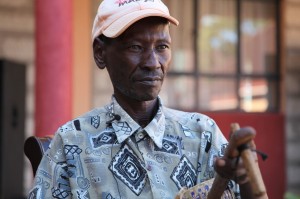
His actual name is Geoffrey Mutwiri, Mbaraka. He is from Kigane Village, Nkevene Sub-location, Nicwene Division. He started performing in 1964 and is from the Meru Ethnic Community. He plays the Wandindi (thus his performance name), which is a ‘tube fiddle’, or what the Luo call the Orutu. He played 6 songs:
Ndaiga Muchiri
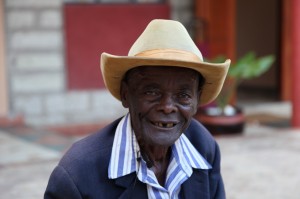
We had heard Ndaiga Muchiri the previous day. He is, if you recall, a founding member of Kangema Mwomboko Dancers and has been performing since 1943. He is from the Kikuyu ethnic community. We loved his performance and wanted to record cleaner versions of his songs and his playing of the Karing’aring,a (metal ring). He sang 5 songs:
- March
- Rumba
- Mwomboko
- Ndongo mothi
- March Again
By this time the sun was setting. We switched locations from the hotel courtyard to a nearby bar.
Kigane Traditional Dancers
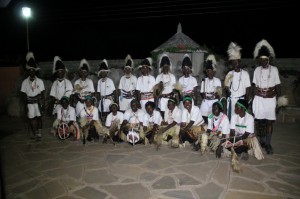
This group is from Kigane Kithurini and Ngatia villages, Suri Location, Bogeta Division.
They are 11 men, 12 women, led by Cyrus Kirigia. Their style is Kwimbo, and the songs ares sung to celebrate the harvest mostly in August and March. They are from the Meru ethnic community and use the Kibere (leg shakers) and Vilingi (whistle).
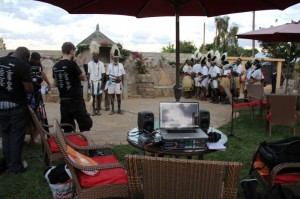
They performed 6 songs, and were performing in the pitch black of night-time as they sang late into the evening (luckily we bring lights, but unluckily, for the video crew, lights bring the bugs).
- Intro: Authi style. Lead singers are Kawi Mwiti and Francis Rithaa.
- Kaura Bechau: Lead singers are Jacob Karia and Mungania Muga. This is for entertaining in all seasons. Its use is unrestricted and is sung in remembrance of Bechau, an elder of Njuri Njeke, who always encourages the community not to forget their culture, especially Njun Njeke, the head of the council of elders.
- Ramare twasemania: Lead is Francis Rithaa and Lawi Mwiti. Is sung by men who are sent to pick the circumciser. They sing the song in two groups, who eventually agree on the choice of circumciser. .
- Barwimbo: Lead singers are Mukumbu Saberio and Jacob Newarimi. Refers to a friend of the opposite sex. It is sung when Ameru are celebrating harvest and having a good time. They sing in male/female pairs to celebrate the harvest season.
- Kirarire: Lead singers are Jacob Karia and Laui Mwiti. The tradition song before circumcision.
- Exit Song: Authi style, lead singers are Francis Rithaa and Cyrus Kirigic. Again, pre-circumcision.
Geoffrey Mutwiri Mbaraka
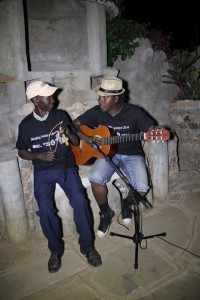
We ended the evening with Geoffrey Mutwiri Mbaraka returning to sing two songs:
- Kilio: An “Influences Song’, where Ralph performed with him on guitar; this is a song about loss as both men struggled in sadness
- The Kenyan National Anthem: He closed our day with a performance on the Wandindi of the national anthem.
Work Practices: Briefing The Groups to Record in the Field
We are gradually learning how to brief the groups before they begin recording. There are typically four issues to address:
The Performance Area: Width and Depth
We work to map out the performance area that will be used, which then sets Video 1’s location. This is a balance. We want to give the groups complete freedom to perform as they would normally do, without our intervention. But we also need a good recording – and too often the groups will stray far off camera and far away from the mics. Or, as often can happen, the leader will plant him or herself directly in front of Video 1, meaning we don’t get a take of the groups. Finally, we use lapel mics on the lead singers so there is always the issue of cables – we try to make sure that the lead vocalist is in front and as much as possible doesn’t dance with the rest. Where this creates real trade-offs, we will do two takes – one with the vocalist stationary and one, without a lapel mic, where they are free to dance as they normally would.
Lead vocalists and instruments
We also work to identify all the major instruments and vocals that will be used and make sure these have appropriate microphones and will be seen by the video team. The purpose of Video 2 is to zoom in on these performances so we want our ‘leads’ stationed close to Video 2 if possible.
Song Length
Our first job is to record the song as written no matter the length. But it is very common for the groups to honour the Singing Wells team by extended their songs – this is a huge complement to the audience. But this can create two separate issues. Our cameras can only record 12 minutes of video at a time and our viewers don’t click as much on very long songs posted on you tube. Assuming that the full story of the song can be told, we work hard to keep performances around 4 minutes in length.
Song Start
Finally, ‘Mr Clapperboard’s’ job (Nick’s) is to ensure that all audio and video instruments are running and then he announces the song/take and claps the clapperboard. He must brief the group to allow him to get off camera before they start this song. We have tried multiple briefings on this and find the best is to simply ask them to wait for Nick to say he’s ‘off camera’ before they begin. But still, we have a lot of Video 1 footage of Nick racing off camera while the group starts. For this reason Video 2 always makes sure we have a zoom shot of the lead singer where Nick is not in the frame. That’s it for Day 3, which was long but incredibly productive.

